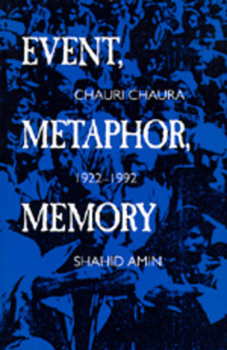Event, Metaphor, Memory: Chauri Chaura, 1922-1992
Select Format
Select Condition 
Book Overview
Taking Gandhi's statements about civil disobedience to heart, in February 1922 residents from the villages around the north Indian market town of Chauri Chaura attacked the local police station,... This description may be from another edition of this product.
Format:Paperback
Language:English
ISBN:0520087801
ISBN13:9780520087804
Release Date:October 1995
Publisher:University of California Press
Length:210 Pages
Weight:1.25 lbs.
Dimensions:0.7" x 5.5" x 8.3"
Related Subjects
Asia Europe Geography History Human Geography India Politics & Social Sciences Social SciencesCustomer Reviews
1 rating
From Event to Metaphor
Published by Thriftbooks.com User , 15 years ago
Shahid Amin discusses the ways in which colonialist and nationalist discourses have been appropriating the incident of Chauri Chaura that took place in the early twentieth century in Northern India. The incident occurred when an angry mob, volunteers for Gandhi's stayagarha movement, burned the police station killing twenty-three policemen. The defiance of the non-violent philosophy naturally turned Gandhi against the perpetrators, after which they were outcast by nationalists and labeled as criminals. This then released the peasants from the sanctions of the political into a regime of criminality thus freeing their bodies from any nationalist connotations. However, after the partition, the post nationalists' state exonerated the same peasants, hailing them as freedom fighters and commemorating the incident as a significant event in the colonial struggle. Thus, Amin revisits the incident through archival and ethnographic research to identify hitherto unheard voices and to demonstrate the significance of decoding and encoding the Chauri Chaura into meaningful complexes of nationalist and postnationalist discourses. "The meaning of Chauri Chaura lies in its ephemeral and metaphoric positioning within the colonial and the national archive." Interestingly, as a historian Amin does not seems infatuated in unearthing the source that led to the incident, which then transformed the event into a metaphor, deployed frequently to any violent event across India. There was no center that provoked the angry peasants. In fact, he was interested in the way local people remember and memorize the event in stories. He outlined a detailed ethnography of people's everyday lives, lives that do not necessarily intersect with nationalist ideology. For instance, the geographical particularities of each village in itself and in relation to other villages, economic structures that underlie the functioning of the peasant population such as various occupational groups, cultural modalities associated with beliefs and values, etc. An important aspect of Amin's thought is his representation of the peasants' interpersonal relationships in the villages by paying careful attention to the nuance and subtleties that usually escape scholar's analysis. For instance, he highlights the kinship pattern of individuals involved in the incident to suggest living and emotional relationships suppressed under the blanket term of mob. Perhaps, Amin suggests one cannot reduce these diverse practices and spaces to a single category of anti-colonial resistance. Nonetheless, his long familiarity with the region allows him a greater access to information that made possible tracing of familial networks along with a social-political milieu of the community. Amin's work suggests the contested nature of the idea of nation. The ways in which Chauri Chaura deploys the tropes of nation and nationalism depend on a spatial-temporal category. For instance, the Chauri Chaura, as an actual event in 1922, fr





